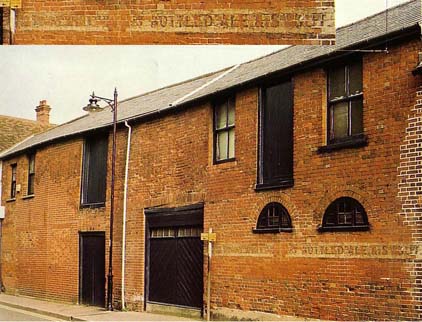Sudbury
Sudbury is
an ancient Suffolk market town which has had
substantial wealth and status in the past and this is reflected in the
fine buildings, many kept in excellent condition. Here we
must
gratefully acknowledge the book 'Sudbury Suffolk: the unlisted
heritage' by David Burnett where almost all of the fine (unlisted)
structures in the town are carefully photographed and documented See
our Reading
List for
details. Naturally, a rich heritage often means that interesting
lettering survives.
'SEWAGE PUMPING STATION
CORPORATION OF SUDBURY
REFUSE DESTRUCTOR WORKS'
Let's not forget the date '19...03' set either side of
the circular
window at the top, festooned with curlicue brick stretchers - or are
they decorative motifs?. The refuse works with its large chimney is
long
gone, but this Sewage Pumping Station survives in Ballingdon Street.


In Station
Road are warehouses belonging to 38 Market
Hill, probably built around 1840. The trading sign painted on
the
decaying bricks:
'WHITBREADS [?] BOTTLED ALE &
STOUT'

38 Station
Road features the former engineering works
of Barton & Co. which became 'Brunton Propellors Limited' (as
shown
on the screw-on lettering below) during World War I. 'ENGINEERS' is
painted on the upper strip and may be laying on a painted strip
covering earlier lettering. Barton & Co. are celebrated all
over
the town lettered into cast iron fittings such as the cellar grille of
the former public house next door, drain covers and on the railing
plates surrounding the cricket ground in Friars Street.

The white brick facade at 54-55 Station Road and was
built in 1867. To prove it, there is lettering on the stone lintel
over the doorway to the left of the street elevation:
'FREE PRESS OFFICE 1867'
 2014
image
2014
image
'SUFFOLK
AND ESSEX
FREE PRESS'
with chiselled caps for
the top two lines and large and
small caps for
the third, centred and positioned (rather high) in a decorative brick
cartouche.

 2014 slightly enhanced image
2014 slightly enhanced image
It is difficult enough photographing this building at
all, but standing in the middle of a very busy road accounts for the
slightly odd framing of the 2014 close-up. It is clear that the
chiselled characters were in-filled with black paint, albeit now
weathered away in the lower lines.
 The central shields representing the two
counties
The central shields representing the two
counties
The first issue of The Suffolk and
Essex Free Press came out on 5 July 1855 and continues to the
present. It began as Free Press and
General Advertiser from 30 August 1855-12 June 1856, then as The West Suffolk and North Essex Free Press
from 20 January 1949-26 November 1981;it then became The Suffolk Free Press.
'GREGORY
MILLS'
in decorative caps with a full stop announces the
Sudbury Silk Weaving
Company's whereabouts, built in 1912. It became Vanners and Fennell in
1924 and is still in business in Gregory Street.

'VICTORIA
HALL
1887'
in Prince Street is an important part of the
intellectual life of
Sudbury. The cast iron plaques have raised surrounds and the impressed
serif'd caps are picked out in black paint, as are the centred dots on
each side.

'18... A.P
...33'
carved into this interestingly shaped detail on the
corner of 65 North
Street. 'A.P' stands for Ambrose Prentice, Grocer and Tea Dealer - the
original proprietor.

'AD ... 1886'
in roundels and leaf decoration on the former adorn the
Masonic Hall in
North Street, built in 1886. The characteristic mason's dividers and
inverted square rest on a ceremonial cushion, all made of white stone,
are flanked by the terra cotta letters and numerals. A similar
configuration of letters and date occurs in Aldeburgh,
the Fludyers Arms in Felixstowe and in
Ipswich: on two Co-op stores, on Castle Hill Community Centre and Morpeth House. An
intriguing masonic device similar to that below is seen with a very
early date on a building in Needham Market.

'THIS WALL
WAS BUILT
AFTER THE FIRE
1890'
The fire occurred in Grimwood's builders yard and
workshop in Church
Walk, which was relocated to Weavers Lane (where Weavers Court now is).
Grimwoods built the appropriately named Phoenix Brewery on the site and
the plaque set into the wall commemorates the fact.

Here in Market Square is a fine example of a proudly
named building serving an entirely different purpose. Topped by farm
workers with sickle and flail and surrounded by sheaves of wheat
looking like flaming torches in stone is the name tablet: 'CORN
EXCHANGE'; now, of course, it is the public library.

Five minutes walk and, between the shopfronts, we come
to one of those postmodern entranceways into nothing:
'FOUNDED 1747
S GREGORY & S PETER SCHOOLS'

The stonework is very worn in places (particularly
around the date).

St Peter’s Church on nearby Market Hill is first
documented in 1180 as a chapel of ease to St Gregory’s,
Sudbury’s oldest church, but the present building is later. A
chapel of ease serves the more distant congregation and is governed by
the mother church, but this role sat unhappily on St Peter’s
which became the centre of its own unofficial parish. This must be the
source of the dedication of the school (or 'schools'). St Gregory CEVCP
School still exists in Church Street and is a voluntary-controlled
school. These schools were originally provided by the Church of England
and educational trusts. They have religious links but Suffolk County
Council now decides the policy for admissions.
Between the bus and the railway stations stands a
former hotel with this obcure lettering high on the side wall:
'GREAT
EASTERN'
withe initials 'R' and 'K' built into the ground floor
walls in
yellow bricks.
 -
-




 2014
image
2014
image
 2014 slightly enhanced image
2014 slightly enhanced image The central shields representing the two
counties
The central shields representing the two
counties







 -
-